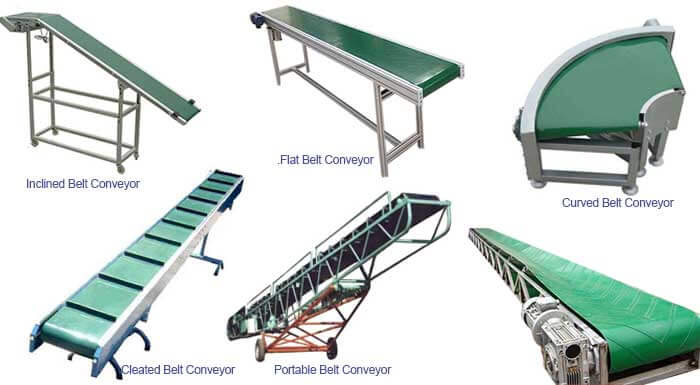10+ Tips Help To Select A Right Conveyor Belt
A conveyor belt is an essential component of an industrial manufacturing line. It is used to move products seamlessly along a production line, from one process to another. Selecting the right conveyor belt is critical in ensuring that the manufacturing process runs smoothly and efficiently. In this article, we will discuss the key considerations in selecting the right conveyor belt.

1. Application
The first consideration is the application of the conveyor belt. This refers to the type of product being transported and the environment in which the conveyor belt will be used. Will the conveyor belt be used to move heavy objects or small products? Will it be used in a clean environment or a dirty one? Will it be exposed to high temperatures or corrosive substances?
The answers to these questions will determine the type of conveyor belt that should be selected. Heavy-duty belts are required for moving heavy objects, while small products require a belt with a fine mesh. A conveyor belt used in a dirty environment will require regular cleaning and a belt that can withstand abrasion. A conveyor belt exposed to high temperatures may require materials that can resist heat.
2. Material
Another consideration when selecting a conveyor belt is the material of the belt itself. The material of the belt should be carefully selected based on the application. Some materials may be better suited for specific applications than others.
The material used to construct the conveyor is also important. Common materials include stainless steel, aluminum, and plastic. The material you choose will depend on the specific needs of your application, such as resistance to corrosion, temperature, or chemicals.
Rubber is a popular material used for conveyor belts due to its durability and flexibility. However, it may not be suitable for high-temperature applications. PVC and polyurethane are also popular materials for conveyor belts, but they may not be suitable for extremely cold environments.
3. Capacity
The important factor to consider when choosing a belt conveyor is the capacity of the system. How much product do you need to transport and at what rate? This will help you determine the size and speed of the conveyor required to meet your needs. Be sure to factor in any future growth projections to ensure that the system can handle increased demand.
4. Belt Thickness
The thickness of the conveyor belt is another crucial consideration. It determines the durability and strength of the belt. A thicker belt is generally more durable and can withstand heavier loads. The thickness of the belt also affects the energy consumption of the conveyor, as thicker belts require more energy to move.
5. Belt length and Width
The length and width of the conveyor belt should also be considered when selecting a belt. The length of the belt is determined by the distance between the two endpoints of the conveyor line. The width of the belt determines the size of the material that can be transported. A wider belt is required for larger or wider materials.

6. Belt Conveyor layout
The length and layout of the conveyor are also important considerations. Will the conveyor be a straight run or will it need to turn, incline or decline? The layout of your facility and the flow of product will play a major role in determining the best configuration for your conveyor system.
7. Belt Type
There are several types of belts available for conveyor systems, including flat belts, modular belts, and timing belts. The type of belt you choose will depend on the product being transported, as well as factors such as speed, noise level, and sanitation requirements.
8. Tension
The tension of the conveyor belt is another important consideration. The tension of the belt determines how tightly it will be held in place. The tension must be carefully calibrated to ensure that the belt does not slip or become loose during operation.
9. Speed
The speed of the conveyor belt is also an essential consideration. The speed of the conveyor belt should be matched to the speed of the production line. It should not be too fast or too slow, as this can affect the product’s quality and efficiency.

10. Maintenance Requirements
It’s important to consider the maintenance requirements of the conveyor before making a final decision. How often will the system need to be inspected, cleaned, or repaired? Are replacement parts readily available, and how easy are they to replace?
11. Safety features
Last but not least, safety features should be a top priority when choosing a belt conveyor. Look for systems that include emergency stop buttons, safety guards, and other features to protect workers from injury.
In conclusion, selecting the right conveyor belt is crucial in ensuring the success of the manufacturing process. It is essential to consider the application, material, thickness, length and width, tension, capacity, length, layout, belt type, material, maintenance requirementsand, speed of the belt when making a decision. Proper consideration of these factors will ensure that the conveyor belt is durable, efficient, and reliable.
 Conveyor Belt Working Principle & Application
Conveyor Belt Working Principle & Application 10 Belt Conveyor Types & 5 Types of Conveyor Belt Materials
10 Belt Conveyor Types & 5 Types of Conveyor Belt Materials 8 Tips Help To Choose A Suitable Screw Conveyor
8 Tips Help To Choose A Suitable Screw Conveyor 16 Methods Help To Solve Belt Conveyor Deviation Problem
16 Methods Help To Solve Belt Conveyor Deviation Problem




I need copnveyor belts that can be used in Printing, Packaging.
Specification as below:
1)Thickness: PVC Belting (1~7mm); PU Belting (0.8~4mm);
2)Width: 200mm ~ 4000mm;
3)Appearance: Flat surface or diamond pattern.
Only waiting for a quote as soon as possible.
Specification as below:
1)Thickness: PVC Belting (1~7mm); PU Belting (0.8~4mm);
2)Width: 200mm ~ 4000mm;
3)Appearance: Flat surface, diamond pattern, lawn pattern, golf pattern, etc.
Looking forward to your quotation.